Over the course of this journey I’ve ridden two bikes: a Santos Travel Master Cromo 2.6 and a Thorn Sterling. Both are 26in, mountain bike-style tourers, which is generally the best way to go for riding south of the US, where 700c (or 29er) touring kit can’t be found for love nor money.
Several people have asked me which of the two bikes is ‘better’. I guess the answer would have to be an ambiguous ‘neither’ – though each is better suited to certain applications. In a nutshell, the Travel Master is burlier and longer, and designed primarily for hauling the heaviest of loads with complete stability. The Sterling is lighter and tighter, and built for smaller capacities and a livelier ride.
I ran both bikes with almost identical kit: Ridiga’s superb CSS Andra rims, Magura’s reliable, coil sprung Odur (85mm for the Travel Master, and 100mm for the Sterling), simple Middleburn square taper cranks, Tubus/OMM racks and a mix of Schwalbe Marathon XR and Extreme tyres, in a fat, trail friendly 2.25. And, of course, Rohloff’s Speedhub, which has worked faultlessly throughout the journey, making short work of muck, dust and snow. Both frames are Rohloff specific and feature eccentric bottom brackets – a neat and easy solution to adjusting chain tension.
As a sidenote, I chose to run suspension on this trip because I’d always intended to unearth singletrack side trips along the way, and because the folks at the Adventure Cycling Association recommended it for the Great Divide Mountain Bike Route. If I wasn’t such a keen mountain biker, I’d probably make do with a rigid fork, fat tyres and some comfortable grips, like the Ergon GP1s or GR2s – which are setup options on both bikes. Ultimately, a rigid fork on a 26in offers better reliability and load carrying abilities, at the expense of comfort over corrugated tracks and some technical prowess when mountain biking.
And another thought worth considering: If you are going to run front panniers with a suspension fork – which is ultimately is not what they’re designed for – pack your bags as light as possible to avoid the fork flexing too much. Keep your bar bag as light as possible too.
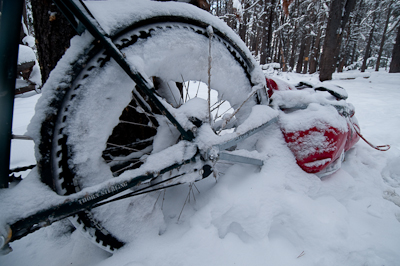
Both bikes were set up with Rohloff’s Speedhub, providing an encased 14 speed drivetrain that’s worked faultlessly, come rain, shine… or snow. This is Robert’s Thorn Sterling, a friend who joined me in Montana.
So, having put in several thousand rugged kilometres in on both bikes, here’s a few thoughts on the pros and cons of each…
SANTOS TRAVEL MASTER CROMO 2.6
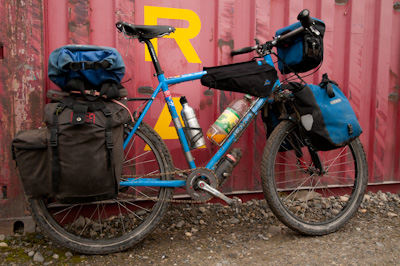
Parked up at Deadhorse, the most northerly point you can cycle to in North America. My setup was heavier here than at any other time on this journey – cold weather kit, electronic gizmos like a netbook, DSLR, a few lenses and a solar charger, as well as nine days of food.
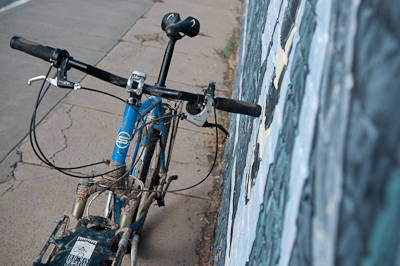
The Santos was fitted for me by MSG Cycles, and I have to say, it’s the most comfortable setup I’ve toured with.
What I like:
Massive tyre clearances for 2.25s, plus room, great for mud, snow and fat tyres – and ‘guards too
Heavy duty, oversized tubing for serious load carrying, handles really well offroad at speed
Loads of bottle mounts, and triple eyelets for positioning options, including below the top tube
The frame is designed for 85mm of suspension, which is ample to take the edge out of potholled and corrugated dirt roads
Derailleur hanger in the event of a Rohloff failure
Surprisingly nippy handling for an expedition bike
Lots of build options to suit different budgets
Tough finish and loads of paint choices to express your individualism…
What I’m not so crazy about:
Oversized tubing offers a tad harsh ride when riding off road unladen, especially with a rigid fork
On the largest size, the head tube is too long for some suspension fork steerers. I was fitted with the largest frame because the top tube is a little shorter than I’m used to, so I needed to go up a size to get the reach MSG Cycles recommended.
I didn’t have much standover clearance with an 85mm fork, though it was fine with a rigid fork
No disc mounts (keeps things simple though, and allows for more compliance in the frame and fork)
THORN STERLING
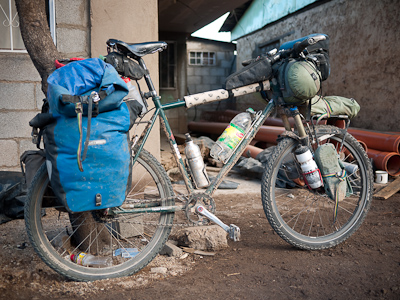
Thorn’s mountain bike derived Sterling, after riding a particularly rough section of forest track in northern Mexico. I’ve hoseclamped some water bottles to the forks for extra water carrying duties and streamlined my setup for the warmer climes of Central America. Gone are the front panniers and the DSLR (for now at least), which suits the lighter capacity of the frame and its suspension fork. I later went on to fit a Porcelain Rocket framebag, which helped to spread weight across the frame.
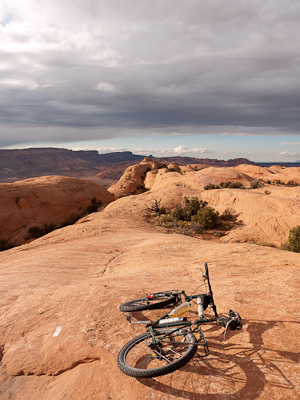
If you like mountain biking, the Sterling makes a great bike for touring the US, as it doubles up as a very capable hardtail; perfect for exploring mtb meccas like Slickrock.
What I like:
Massive tyre clearances for 2.25s plus room, great for mud, snow and fat tyres – and ‘guards too
Lighter, narrow gauge tubing for lively handling unladen – this is a fun bike to ride
Reassuringly solid too compared to some steel hardtails
Versatility – good for touring, mountain biking and commuting
A blast to ride off road
100mm fork is perfect for all but the most challenging of terrain on singletrack sidetrips, and more easily sourced than 85mm lengths
Disc mount for versatility back home and future proofing
Tough finish
Lost of build options to suit your taste
What I’m not so crazy about:
If overloaded, the frame gets a little wallowy. Bear in mind that it’s rated by to 15kg at the back, which should be enough for frugal packers but not everything-but-the-kitchen-sink tours.
Disc brake hose guides aren’t open ended, which would make for easy swapping between discs (home use) and V brakes (on tour).
Disc mount could have been be tucked away between the rear stays, so a mechanical disc caliper, like Avid’s reliable BB7, wouldn’t foul a rear rack.
For water guzzlers or those with desert touring inclinations, an extra bottle mount below the downtube would have been welcome.
Longer 100mm suspension fork less suited to loaded travel as it has a little more flex in it. This said, 80mm forks are hard to come by these days, so it’s easier to find a replacement in the event of a failure.
Verdict:
If there’s to be a verdict of sorts, I’d say the most important point to bear in mind is that you can’t shoe horn everything into one bike. Both bikes are very nicely thought out, and definitely fulfill their respective mandates – my minor grumbles aren’t deal breakers in any way.
So, if you pack relatively light and enjoy unladen mountain biking side trips, the Sterling is a great choice: it combines fun, nimble handling with respectable touring credentials. Plus, it’s a touch beefier than a standard steel hardtail, so should swallow up some bruises too. In terms of build, the frame is very nicely finished, and comes properly prepped too.
If you really want to load up the Sterling, Thorn do a rigid fork, the Mt Tura, which is rated to 25kg – adding substantially to the frame’s capacity of 15kg. But if you’re keen to run suspension, as I was, then the ideal setup for the Sterling may well be a combination of two rear panniers and custom frame bag, from the likes of Epic Designs, Carousel or Porcelain Rocket. Framebags help spread weight within the frame, rather than loading up the fork with a rack and panniers. For extra water carrying capacity, I hoseclamp water bottle cages to the fork legs without any detrimental effect on handling.
Of course, there’s nothing to stop you running the Sterling with a single wheel trailer, like an Extrawheel, BOB or Aevon – thus entering into a whole different world of load carrying. For more generous cargos though, you should really be checking out its beefier brother, the Thorn Nomad, which also come with S&S couplings for air transport.
Onto the Santos.
If you’re planning an extended, heavily loaded dirt track adventure through a gamut of seasons, the Travel Master will definitely do you proud. I was impressed with pretty much everything about it. It’s ruggedly built and attention to detail is absolutely spot on. Like the Thorn, it’s very nicely put together. And like the Thorn, there’s plenty of build options. The way the sizing worked out for me, a rigid fork would have been a better option than suspension, as standover was a touch tight for more technical riding. There’s a aluminium version with a slightly shorter head tube – and hence more standover – which also has a longer top tube, but I’m a traditionalist (of sorts) and prefer to tour with a chromo frame.
Which is a good reminder that it’s worth checking frame geometries out too – the Santos being noticeably shorter on the top tube than the Sterling. I had my Santos bikefitted for me by MSG Cycles, and I have to say, they did a great job.
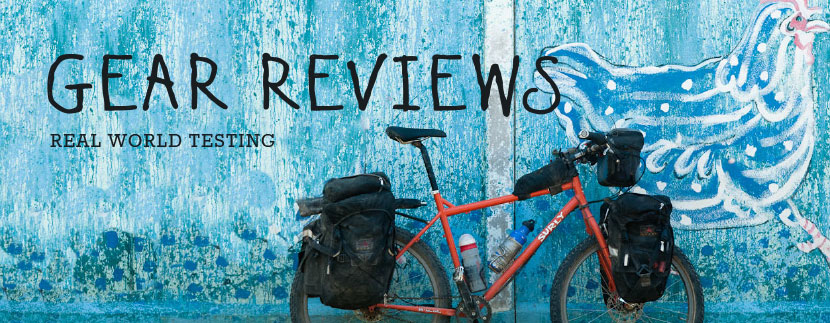
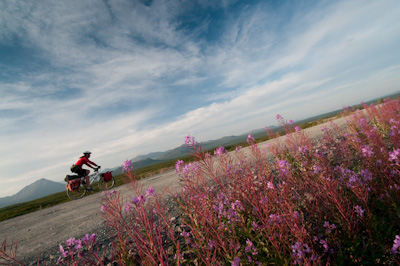

Hey Cass,
Loving the blog still. Mexico seems like a great place to tour. What type of brakes are you using?
Hi jack. Thanks! I´m using Swiss Stop blue pads, as you need a different compound for the tungsten carbide rims. I think I´m only on my second set for the whole trip – they last an age.
Whats happening Cass…
I’m really enjoying your updates and pictures. Keep up the great work! What is your gear situation? Are you single speed? Thank ya!
Thanks.
Singlespeed? Ouch, not on this ride, for me at least… Got a Rohloff hub, with 14 internal gears.
Hi Cass,
I guess I’m not the only bike nerd then…
How do you get on with the Carradice Super C panniers?
I’m off to India soon and am eyeing these panniers rather than the more common Ortlieb rollers. The carradice ‘appear’ to be a little more durable?
I’m planning on the panniers, a large dry bag on rack and just an Epic Designs handlebar system with a drybag up front.
Hopefully this will prove enough for a months riding and camping.
Cheers
I like them, and they definitely are tough, even if you take a fall. Easy to repair. Wear in nicely, and look low key after a few months of use. I ended up fitting two anti sway clips though, to keep them nice and stable. I love the massive rear pockets.
Hi there,
Nice blog – amazing pics. DSLR? I carry full frame shit myself, but man it’s heavy..
Considering a Travel Master similar to yours. Anything you would change if you could?
Belt drive. Worth going for since I’m buying a new frame anyway? Did you try it?
Eccentric BB. Any experience with those things?
Bike fitting? worth traveling for if frame size is a done deal?
And another one for the Super C panniers – not missing the 100 pct waterproof effect?
Cheers
Chris
I m using a Lumix Micro 4’3rds camera. Not half as nice as a full frame, but considerably less than half the weight…
No experience with belt drives myself, but I d love to try one out – seems the way forward.
I m a fan of Eccentric BBs, no problems on the Santos and the Thorn.
The bikefitting worked out really well for me, even though the frame was stock. So I d recommend it.
Yes and no. No, most of the time. Yes, in the rainy season! Actually though, right now, I m using a set of Arkel XM45s, which are really nice too. I dont have the raincovers, but with these, they should be all but monsoon proof…
Hi Cass, love the site. Great writing and photos – a rare combination.
I’m curious if you are still enjoying the suspension? It’s not something often recommended for touring bikes (just one more thing to go wrong) but, like you, we find ourselves wanting to do more and more off road routes like the Great Divide; trails in NZ, Spain and South America…
Have you had any problems with it? Are there any reasons that you’d switch back to rigid forks?
Thanks for any thoughts.
Friedel
Hey guys,
There’s pros and cons… For a long trip, there’s obviously the reliability issue. A year and a half in, and my Magura forks are pretty much dead (combination of wear and tear, and lack of servicing). But I consider that to be pretty good value for what I’ve got out of them, and I have searched out challenging terrain. They have definitely been a plus for general comfort (over corrugation for example) and off road performance, if you like singletrack side forays.
The other downside is that suspension forks don’t like to be loaded up too much – they can get very squirrely. So you need to pack light, which is probably the way you’d want to go if you’re planning to ride off road terrain.
Until I figure out getting a replacement (finding coil sprung forks isn’t so easy now days) I’m now on a rigid fork and fat tyres, another way of getting more comfort from your setup when riding off road.
Pingback: A troll is born (in Costa Rica) « while out riding
Hey There!
I came across your blog when searching for foto’s of bikes with suspension forks that have water bottles attached to them 🙂 Love google 🙂
Which mounting system did you use? I can only find the Rixen &Kaul Bottlefix, am wondering if there are other brands, or good/bad options for this.
Furthermore, we’re currently changing from a rigid fork to suspension forks on our santos travelmaster. I normally don’t ride with front panniers anymore, and bought a revelate design handlebar carrier for more room for our luggage on more extended trips. My partner normally does have the front panniers, but we don’t want this anymore with suspension forks (new rack is expensive, and there is no guarantee on the forks anymore apparently, when using a front rack with panniers + not comfy i guess). My partner has a Ortlieb handlebar bag/box for our DSLR so we can’t really dish that one, but we would like to attach a drybag under/behind that bag. I see in your picture above that you managed to get a dry-stuffbag behind the ortlieb at your handlebar. Did you use an extension of the mounting system of the ortlieb to do that, or did it just fit? I looked at our bikes a couple of times and don’t really see how I can reliably attach a drybag at his handlebar… Can you give some closer pics/advice?
+ ps we also made our own framebags: works super! I have a 4liter waterbag in it, perfect way of transporting lots of water.
Thanks for your time!
Hey there.
I use good, old fashioned hose clamps, which you can pick up in any hardware store, along with a cage that has enough of an ‘edge’ for them to clasp onto.
I use one of Porcelain Rocket’s bags, jammed between the headset and the bar bag, with a standard mount. I guess how well this works depends to some extent on how long the stem you are running is. It’s a bit of a squeeze.
A pic of a similar one to the one I use is here:
http://www.flickr.com/photos/porcelainrocket/6550714907/in/photostream
But in the past, I just sewed a couple of attachement points on a dry bag and seam sealed the stitching. They’ll be some wear from the headtube though, and maybe the brakes. Gorilla tape works well to add extra life to dry bags.
Quick question regarding brakes, did you have any problems with rim wear running V-Brakes on such a long stretch of your tour? Especially when it got nice and grim up on the divide route.
Good luck when you pick-up your ride again, looking forward to your ride commentary!
Mark,
The wheels on my Thorn Sterling – the last bike I had with V brakes – used Rigida’s amazing CSS coating, a tungsten carbide finish similar to ceramic, that eeks incredible life out of wheels in all kinds of conditions. 10,000kms in, and they barely looked touch. You do, however, need to run different brake pads – Swiss Stop blues are meant to be the best, and one minor downside is that they can be really noisy before they’ve bedded in. If it hadn’t been for the fact I moved to BB7s (and a 29er) I’m sure I’d still be using those wheels.
I definitely think the CSS finish is worth the investment. Otherwise, a stout rim like a Sputnik should have plenty of life in it. In terms of the Great Divide, V brakes can be a bane on those New Mexican dirt roads, if you hit them during the monsoon season. But then again, nothing gets through that stuff…
Rohloff Equipped Thorn Nomad MKII all the way baby !